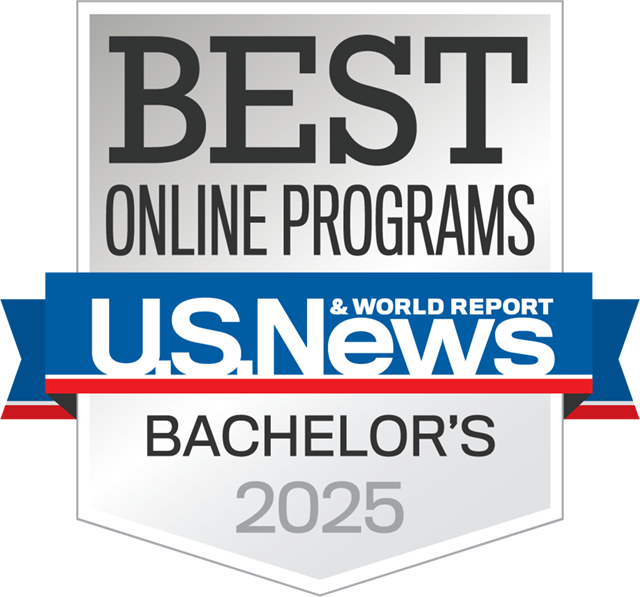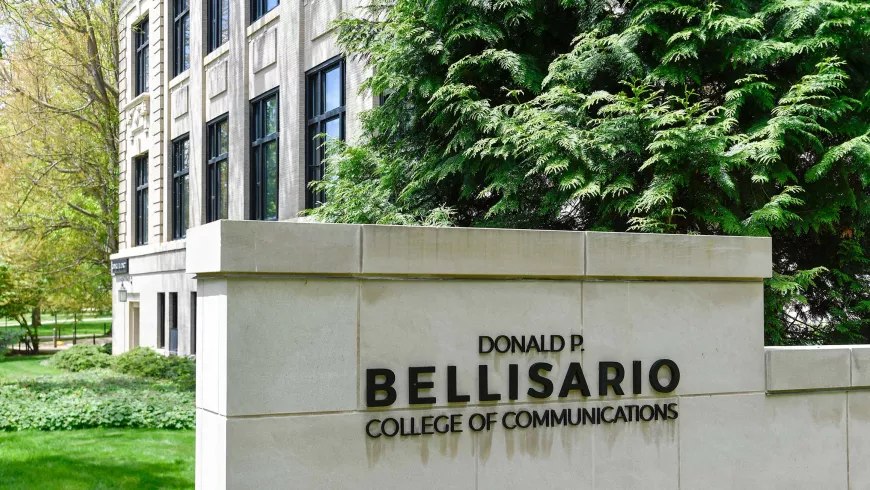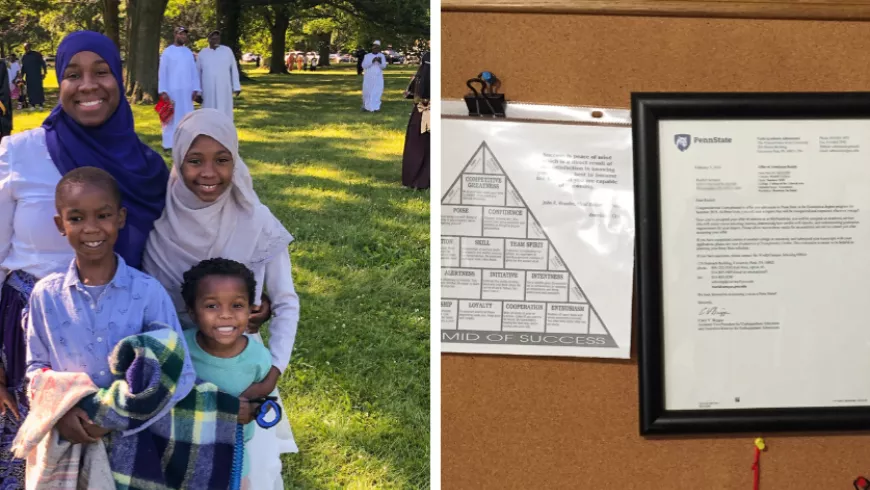100% Online
Complete your Penn State course work at your own pace and 100% online.
Application deadline
Credits and costs
Nationally Recognized

Gain Skills to Develop Content Strategically and Communicate Effectively
Use critical thinking and complex problem-solving to select the best communication channels for proper message distribution and retention.
Cultivate an organization's image and reputation based on analysis of the political, economic, technological, digital media, and social environments to increase its revenues and foster goodwill.
Evaluate communication efforts against established goals and benchmarks.
Conduct organized communications campaigns to influence the public image of a person or organization, or to promote a product or initiative with maximum efficiency.
Sharpen your creative thinking in addition to your oral, visual, and written communication.
Strategic Communications Courses
Strategic Communications Courses
In the strategic communications major, you'll have the opportunity to study psychology, statistics, law, research, and other disciplines that can be used to build a solid foundation for effective communication for any company or organization.
The Bachelor of Arts in Strategic Communications program requires you to complete a minimum of 120 credits.
A student enrolled in this major must receive a grade of C or better in all prescribed, additional, and supporting courses required for the major.
Students can earn up to six (6) COMM credits through the credit-by-portfolio process. However, it is important for students to know that completing the credit-by-portfolio process does not guarantee that the credits will be awarded.
If you are a transfer student, the number of credits you must take will vary according to the courses that transfer into the program. Once you are admitted to the program, your assigned academic adviser can help you select courses to fulfill the remaining requirements.
Prescribed Courses (29 credits)
- 1credit
Grammar, punctuation, spelling, and word usage skills required of journalists.
- 3credits
This course is an introduction to writing for various kinds of mass communication media. Students will practice writing public relations news releases; public information announcements; print, television and radio advertisements; and news stories and editorials. Students will be given weekly writing assignments, some of which will be re-writes of earlier submissions. In-class exercises will include various writing exercises designed to get students more comfortable with writing for media.
- Prerequisite
ENGL 15 and ENGL 202
- 3credits
Provides an overview of the various media and communications methods that comprise modern integrated marketing campaigns.
- 3credits
Analysis of laws and regulations affecting online advertising and strategic communications.
- Prerequisite
COMM 428A and permission of the program
- 3credits
Framework for applying public relations and advertising tools across media platforms and across cultures.
- Prerequisite
COMM 428A, COMM 428D and permission of the program
- 3credits
Online research methods for strategic communication, including web analytics, online surveys, online interviews, and content analysis.
- Prerequisite
COMM 428A, STAT 200 and permission of the program
- 3credits
Social media — including social networks, visual content, podcasts, blogs and other collaborative content creation platforms — are changing the field of public relations. To effectively deploy social media to reach brand objectives, public relations professionals need to understand the critical roles of strategy as well as content creation. This course narrows the focus from the broad field of social media to cover the specific tools and best practices needed to conquer current and future use of social media in public relations
- 3credits
Methods of economic analysis and their use; price determination; theory of the firm; distribution.
- 3credits
Introduction to general psychology; principles of human behavior and their applications.
- 4credits
Descriptive statistics, frequency distributions, probability, binomial and normal distributions, statistical inference, linear regression, and correlation.
Additional Courses (select 3 credits)
- 3credits
Nature and theories of law; the Supreme Court and press freedom; legal problems of the mass media.
- 3credits
Ethical problems in the practice of journalism; principal public criticisms of news media; case study approach.
- 3credits
Sport and media relationship in American culture.
Supporting Courses (select 3 credits)
Select 3 credits of COMM courses other than COMM 100 or COMM 120.
Electives (26 credits)
Students should choose 26 additional credits to satisfy the electives requirement.
General Education Requirements
Some General Education requirements may be satisfied by courses required for the major. Students should work with an adviser to select courses.
- Foundations: 15 credits
All courses require a grade of C or better. Inter-Domain courses may not be used for foundations requirements.- Writing/Speaking: 9 credits
- Quantification: 6 credits
3-6 credits are selected from mathematics, applied mathematics, and statistics; 3 credits may be selected from computer science or symbolic logic.
- Knowledge Domains: 15 credits
Inter-Domain courses may not be used for knowledge domain requirements.- Health and Wellness (GHW): 3 credits
- Natural Sciences (GN): 3 credits
- Arts (GA): 3 credits
- Humanities (GH): 3 credits
- Social and Behavioral Sciences (GS): 3 credits
- Integrative Studies: 6 credits
- Inter-Domain course work: 6 credits
- Exploration: 9 credits
- Natural Sciences (GN) (may be Inter-Domain): 3 credits
- GA, GH, GN, GS, and Inter-Domain courses: 6 credits
May include 3 credits of World Language course work beyond the requirements of the student’s degree program or at the 12th credit level, whichever is higher.
These General Education Requirements are for students who started in summer 2023 or later. Students who started earlier can review the prior version of the general education requirements.
Bachelor of Arts Degree Requirements
Some Bachelor of Arts requirements may be satisfied by courses required for the major, General Education courses, or electives. Students should work with an adviser to select courses.
- Foreign Language: 0–12 credits
Students must attain 12th credit level of proficiency in one foreign language. - B.A. Fields: 9 credits
Humanities, Social and Behavioral Sciences, Arts, Foreign Languages, Natural Sciences, Quantification (cannot be taken in the area of the student's primary major; foreign language credits in this category must be in a second foreign language or beyond the 12th credit level of proficiency in the first language) - Other Cultures: 0–3 credits
Select 3 credits from approved list. Students may count courses in this category in order to meet other major, minor, elective, or General Education requirements, except for the General Education US/IL requirement.
Course Availability
If you're ready to see when your courses will be offered, visit our public LionPATH course search (opens in new window) to start planning ahead.
Start or Advance Your Career

Start or Advance Your Career
This online bachelor’s degree program can make you a valuable asset for businesses, corporations, government, and nonprofit organizations. You can use the knowledge gained from this program and the support of Penn State career resources to pursue careers in a variety of fields, depending on your goals.
Job Titles Related to This Degree
This program is an ideal course of study if you want to work in a dynamic environment where you can gather and analyze information to create targeted, comprehensive communication strategies that can help advance your organization's objectives.
The following roles are often held by people with this type of degree:
- Communications Manager
- Communications Specialist
- Media Specialist
- Public Affairs Specialist
- Public Relations Manager (PR Manager)
- Public Relations Specialist (PR Specialist)
Employment Outlook for Occupational Fields Related to This Degree
Estimates of employment growth and total employment are provided by the U.S. Bureau of Labor Statistics and are subject to change. While these occupations are often pursued by graduates with this degree, individual outcomes may vary depending on a variety of factors. Penn State World Campus cannot guarantee employment in a given occupation.
Public Relations Specialists
Public Relations Managers
Advertising and Promotions Managers
Additional Opportunities as a Strategic Communications Graduate
As a successful graduate, you can expand your career opportunities in a wide variety of fields involving media and communications occupations and may have the opportunity to:
- analyze and manage advertising, public relations, corporate communication, and integrated marketing communications efforts to ensure a positive public image of a company or brand
- develop and maintain relationships and communication with an organization's stakeholders
- set goals and plan projects to help an audience retain your message
Career Services to Set You Up for Success

From the day you're accepted as a student, you can access resources and tools provided by Penn State World Campus Career Services to further your career. These resources are beneficial whether you're searching for a job or advancing in an established career.
- Opportunities to connect with employers
- Career counselor/coach support
- Occupation and salary information
- Internships
- Graduate school resources
Upcoming Events
Ready to Learn More?
Get the resources you need to make informed decisions about your education. Request information on this program and other programs of interest by completing this form.
Ready to take the next step toward your Penn State bachelor's degree?
Costs and Financial Aid
Costs and Financial Aid
Learn about this program's tuition, fees, scholarship opportunities, grants, payment options, and military benefits.
Costs and Financial Aid
Undergraduate Tuition
Undergraduate tuition is calculated based on the number of credits for which you register and the number of total credits you have accrued at or transferred to Penn State.
Tuition is due shortly after each semester begins and rates are assessed every semester of enrollment.
2024–25 Academic Year Rates
| How many credits do you plan to take per semester? | If you have 59 or fewer credits | If you have 60 or more credits |
|---|---|---|
| 11 or fewer | $632 per credit | $678 per credit |
| 12–19 | $7,678 per semester | $8,288 per semester |
2025–26 Academic Year Rates
| How many credits do you plan to take per semester? | If you have 59 or fewer credits | If you have 60 or more credits |
|---|---|---|
| 11 or fewer | $638 per credit | $685 per credit |
| 12–19 | $7,755 per semester | $8,371 per semester |
Undergraduate students taking more than 19 credits will be charged the flat tuition rate plus the regular per credit hour rate for each credit above 19.
Financial Aid and Military Benefits
Some students may qualify for financial aid. Take the time to research financial aid, scholarships, and payment options as you prepare to apply. Federal financial aid may only be used to pay for credits used to satisfy program requirements.
Military service members, veterans, and their spouses or dependents should explore these potential military education benefits and financial aid opportunities, as well.
Additional Cost of Attendance Details
To view the detailed list of cost of attendance elements:
- visit the Tuition Information site
- click the plus sign to expand the table
- select a semester from the World Campus row
Strategic Communications at Penn State
You can earn a strategic communications degree from one of the largest communications colleges in the country, with courses that allow you to follow your interests and are taught by a diverse faculty with a broad range of academic and real-world experience.
Set Your Own Pace

Set Your Own Pace
Whether you are looking to finish your program as quickly as possible or balance your studies with your busy life, Penn State World Campus can help you achieve your education goals. Many students take one or two courses per semester.
Our online courses typically follow a 12- to 15-week semester cycle, and there are three semesters per year (spring, summer, and fall). If you plan to take a heavy course load, you should expect your course work to be your primary focus and discuss your schedule with your academic adviser.
To Finish Your Degree in Two to Three Years
- Take 6 courses each semester
To Finish Your Degree in Three to Four Years
- Take 4–5 courses each semester
To Finish Your Degree in Five or More Years
- Take 2–3 courses each semester
Timelines may vary for students transferring credits from another school or based on course availability.
Convenient Online Format
This program's convenient online format gives you the flexibility you need to study around your busy schedule. You can skip the lengthy commute without sacrificing the quality of your education and prepare yourself for more rewarding career opportunities without leaving your home.
A Trusted Leader in Online Education

Penn State has a history of more than 100 years of distance education, and World Campus has been a leader in online learning for more than two decades. Our online learning environment offers the same quality education that our students experience on campus.
How to Apply to Penn State

How to Apply to Penn State
Apply by June 30 to start August 25
Application Instructions
Deadlines and Important Dates
Complete your application and submit all required materials by the appropriate deadline. Your deadline will depend on the semester you plan to start your courses.
Fall Deadline
Apply by June 30 to start August 25Spring Deadline
Apply by October 31 to start January 12Summer Deadline
Apply by March 15, 2026, to start May 18, 2026
New students are encouraged to complete the FAFSA by March 1. Please visit the Office of Student Aid website for more information about applying for financial aid and recommended deadlines.
Steps to Apply
To apply for this program, you must be a high school graduate, or have completed your GED.
You will need the following items to complete your application:
High school transcripts or GED transcript — First-year applicants are required to submit Self-Reported Academic Records (SRAR) when applying. Official high school transcripts for first-year applicants will only be required at the time a student accepts an offer of admission to Penn State.
Transfer international students will need to submit their high school transcript before their application can be reviewed.
Official college or university transcripts and/or official military transcripts (if applicable) — All college or university transcripts are required regardless of the length of time that has passed, the grades earned, or the accreditation of the institutions attended. Acceptance of transfer credit toward your degree is subject to final approval by the academic department. For detailed information, see the Transfer Students page.
Transcripts not in English must be accompanied by a certified translation.
English Proficiency — The language of instruction at Penn State is English. With some exceptions, international applicants must take and submit scores for the Test of English as a Foreign Language (TOEFL) or International English Language Testing System (IELTS). Minimum test scores and exceptions are found in the English Language Proficiency section on the Undergraduate Admissions International Requirements page. Visit the TOEFL website for testing information. Penn State's institutional code is 2660.
To begin the online application, you will need a Penn State account.
Create a New Penn State Account
If you have any problems during this process, contact an admissions counselor at [email protected].
Please note: Former Penn State students may not need to complete the admissions application or create a new Penn State account. Please visit our Returning Students page for instructions.
Accessing MyPennState
The MyPennState Portal provides access to our online admissions services. Before accessing MyPennState, you must have a Penn State account that will be used to access all Penn State systems. After creating an account, you will receive a unique Penn State User ID. You will need to enter your User ID followed by @psu.edu when signing in to MyPennState and other Penn State sites. For example, you should be entering something like '[email protected]' in the Sign In field.
The application consists of six sections:
- Application Setup
- Program of Study
- Citizenship and Residency
- Academics and Experience
- Miscellaneous
- Review and Submit
Application Setup
Be sure to select "Online" for the "How would you like to complete your degree" question if you plan to attend Penn State World Campus.
The rest of this section will ask some basic questions about your education experience and military affiliation.
Program of Study
You will choose the degree type and then the starting semester.
Your starting campus will be selected as Penn State World Campus by default as long as you picked "Online" in your Application Setup. Click Continue.
On the Choose a Program page, select your intended major from the list.
Review your selection on the summary screen and click Continue to move on to the Citizenship and Residency section.
Citizenship and Residency
Complete the series of questions about your citizenship status, demographic information, Pennsylvania residency status, and family history.
Academics and Experience
You will need to enter academic experience information about your high school and any attempted courses at a college or university after high school.
The Education Gap Statement offers a place to explain any time that has elapsed between your high school graduation and your anticipated enrollment at Penn State. Please provide a summary of why that gap occurred. Some examples that would explain a gap in your education include work, family, attending another college or university, etc.
Miscellaneous
In the Miscellaneous section, you will provide any program-specific requirements (e.g., a personal statement), information about activities, and financial aid information.
Review and Submit
Review your information, digitally sign your application, and provide payment for the application fee ($65 domestic or $75 international).
High School Transcripts and Academic Record
After your application is completed, you will also need to self-report your high school course work before the application deadline. You will be directed to fill out the Self-Reported Academic Record (SRAR). It is helpful to have a high school transcript available when completing this section. In the third section, you'll select your program of study and campus.
Official high school transcripts or GED transcript, along with records from high school, are required, regardless of the length of time that has passed.
Include any college/university transcripts (required), military transcripts, and Proof of English Language proficiency (if applicable). SAT/ACT scores are not required if you are identified as an adult learner or transfer student.
All official documents should be sent to:
Undergraduate Admissions Office
The Pennsylvania State University
201 Shields Building
University Park, PA 16802You can also have your transcripts sent electronically through Parchment, eScript-Safe, or the National Clearinghouse directly to Penn State from the college/university where course work was attempted.
Acceptance
After receiving your application, application fee, and all required materials, your application will be evaluated for admission. You can check your application status online. This will provide the most up‐to‐date information about the status of your application and is updated once daily, before 8:00 a.m. (ET). Once a decision has been made regarding your application, it will be available to you through the MyPennState portal.
For information on when you can expect an admissions decision, visit the Dates and Deadlines page of the Undergraduate Admissions website. Make sure you click the "+" sign to see these dates for World Campus Applicants (First-Year and Transfer).
5. Complete the application.
Admissions Help
If you have questions about the admissions process, contact an admissions counselor at [email protected].
Contact Us

Contact Us
Have questions or want more information? We're happy to talk.
To learn more about the Bachelor of Arts in Strategic Communications, please contact:
World Campus Admissions Counselors
Phone: 814-863-5386
Email: [email protected]
Michelle Baker, Ph.D.
Assistant Teaching Professor & Director of Online Programs in Strategic Communications
Donald P. Bellisario College of Communications
The Pennsylvania State University
115 Carnegie Building
University Park, PA 16802
Email: [email protected]
Learn from the Best
Learn from the Best
In this program, you will study with highly regarded faculty from the largest accredited school in its field, the Donald P. Bellisario College of Communications. As a graduate, you become part of a worldwide network of more than 750,000 alumni, increasing your networking potential.
Faculty
Shannon Kennan
- DegreePh.D., Mass Communications, Penn State
- DegreeM.Ed., Counseling Psychology, College Student Personnel Administration, James Madison University
- DegreeB.A., Early Childhood Education, University of Richmond
Dr. Shannon Kennan is a teaching professor and serves as the first-year seminar coordinator and the curriculum coordinator for journalism. Her teaching expertise focuses on applying ethics and DEIB to mass comm industries. Shannon's educational experiences provide a mix of skills that allow her to bring a student-centered focus to her teaching. She has worked in higher education in a variety of administrative and teaching roles since 1995 and joined the Donald P. Bellisario College of Communications in 2011 as the director of eLearning Initiatives to build the existing portfolio of online and hybrid courses and programs.
Andy Lingwall
- DegreeEd.D., Educational Leadership and Policy Studies, University of Washington
- DegreeM.Ed., Educational Leadership and Policy Studies, University of Washington
- DegreeB.S., Public Relations, University of Florida
Dr. Andrew Lingwall has taught communications courses for Penn State World Campus since 2014. Dr. Lingwall has worked as an account executive with Russell & Herder Advertising and PR in Minnesota and as a public relations specialist with Tacoma Community College in Washington state. He also served eight years as a freelance features writer with The News Tribune in Tacoma. Dr. Lingwall is the co-author of the textbook The Basics of Media Writing: A Strategic Approach (SAGE, 2017). In 2019, Dr. Lingwall was selected to be a Scripps Howard Foundation Visiting Professor in Social Media by the Association for Education in Journalism and Mass Communication. He has taught internationally, at Catholic University in Lille, France, and at Universidad de Alcalá near Madrid, Spain. In 2017, he studied public relations education in Aalborg, Denmark, and in 2023, he traveled to New Zealand to study the government’s crisis communications messaging during the COVID-19 pandemic. Dr. Lingwall teaches COMM 230W.
Renea Nichols
- DegreeM.S.T.R, Arizona State University
- DegreeB.A., Journalism, Central Michigan University
Professor Renea Nichols is an associate teaching professor in the Department of Advertising and Public Relations at the Donald P. Bellisario College of Communications. She has held public relations positions with the City of Phoenix, U-Haul International, Arizona Special Olympics, and the ASU Alumni Association. Professor Nichols has also served as a public relations consultant to organizations such as the National Kidney Foundation, the Maricopa Association of Governments, and many top public relations agencies in Arizona. She has worked as a reporter for daily newspapers in Michigan, Maryland, and Ohio. Professor Nichols is the author of four books on interracial dating and multi-racial populations and has appeared in national news media to discuss these topics. She teaches COMM 230W.
Carmina Pérez
- DegreeMPS, Strategic Communications, Penn State
- DegreeB.B.A., Finance, University of Miami
Professor Carmina Pérez has taught communications courses for Penn State World Campus for several years. She had a 14-year career in sales and marketing on Wall Street. Her financial background opened doors to a position in TV, and she worked as an editorial producer for CNN Financial News for six years. After that, she became a web editor at AOL, where she caught the "internet bug" and has been working in digital marketing for 15-plus years. In her last job, she worked as a senior specialist at an NYC–based non-governmental organization (NGO) similar to UNICEF, doing digital fundraising. Through the years, she has worked in many different industries and has collaborated on a variety of marketing campaigns, from print and TV to web and digital. Professor Pérez received the Dean’s Excellence Award for Faculty Affiliate in 2023. She teaches COMM 230W, COMM 428A, and COMM 428C.
Dave Wozniak
- DegreeMBA, Marketing and Finance, Penn State
- DegreeB.S.J., Journalism, University of West Virginia
Professor Dave Wozniak is the Donald P. Bellisario Career Advancement Professor and an assistant teaching professor in the Department of Advertising and Public Relations. He served as vice president of advertising and sponsorships for Lincoln Financial Group. During his 15 years at Lincoln Financial, he was responsible for initiatives that built a strong brand for the organization, including strategy development, consumer and business-to-business advertising programs, content and social media strategy, corporate identity management, and brand communications program integration. Professor Wozniak was also responsible for overseeing Lincoln’s partnership with the Philadelphia Eagles. Under his leadership, several Lincoln campaigns have been recognized for communications excellence, including the Financial Communications Society and EFFIE awards. Professor Wozniak teaches COMM 428A.
Bill Zimmerman
- DegreeM.Ed., Higher Education, Penn State
- DegreeB.A., Journalism, Indiana University of Pennsylvania
Professor Bill Zimmerman is an assistant teaching professor in the Department of Advertising and Public Relations at the Donald P. Bellisario College of Communications. Prior to this, Professor Zimmerman worked in Penn State’s Office of Strategic Communications, where he wrote and edited for the web and photographed scenes and people on campus. He produced a slice-of-life YouTube series called "This is Penn State” and assisted in managing the University’s chief social media accounts. Professor Zimmerman spent nearly a decade as a journalist at a daily newspaper in western Pennsylvania. He is the faculty supervisor for the CommAgency’s social media division. He teaches COMM 428E.
News




